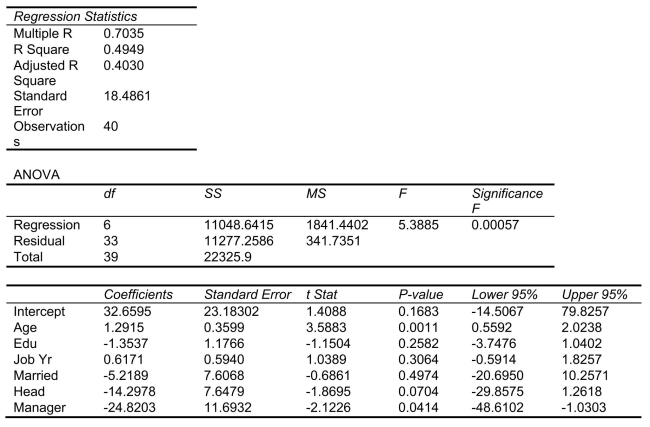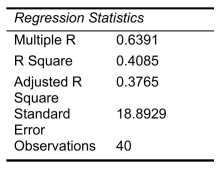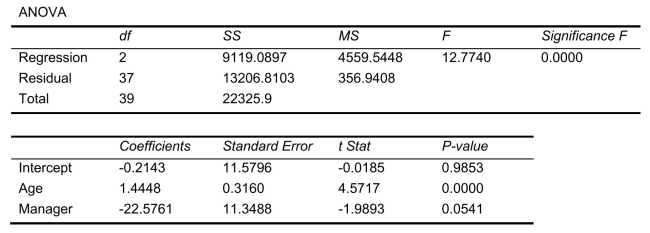SCENARIO 18-10 Given below are results from the regression analysis where the dependent variable is the number of weeks a worker is unemployed due to a layoff (Unemploy)and the independent variables are the age of the worker (Age), the number of years of education received (Edu), the number of years at the previous job (Job Yr), a dummy variable for marital status (Married: 1 = married, 0 = otherwise), a dummy variable for head of household (Head: 1 = yes, 0 = no)and a dummy variable for management position (Manager: 1 = yes, 0 = no).We shall call this Model 1.The coefficient of partial determination  of each of the 6 predictors are, respectively, 0.2807, 0.0386, 0.0317, 0.0141, 0.0958, and 0.1201.
of each of the 6 predictors are, respectively, 0.2807, 0.0386, 0.0317, 0.0141, 0.0958, and 0.1201.  Model 2 is the regression analysis where the dependent variable is Unemploy and the independent variables are Age and Manager.The results of the regression analysis are given below:
Model 2 is the regression analysis where the dependent variable is Unemploy and the independent variables are Age and Manager.The results of the regression analysis are given below: 

-Referring to Scenario 18-10 Model 1, we can conclude that, holding constant the effect of the other independent variables, there is a difference in the mean number of weeks a worker is unemployed due to a layoff between a worker who is married and one who is not at a 10% level of significance if we use only the information of the 95% confidence interval estimate for 
Definitions:
Cigarette Taxes
Taxes imposed on the sale of cigarettes to increase revenue for the government and discourage smoking by raising prices.
Inelastic
A characteristic of demand or supply that shows a small response or change to variations in price levels.
Excise Tax
A tax levied on specific goods, services, and activities, such as alcohol, tobacco, and gasoline, often to discourage their use or generate revenue for a specific purpose.
Demand for Pumpkins
denotes the consumers' willingness and ability to purchase pumpkins at various prices, influenced by factors such as seasonality, price, and consumer preferences.
Q5: The Shewhart-Deming cycle plays an important role
Q22: Referring to Scenario 18-6, what is the
Q42: A medical doctor is involved in a
Q62: Referring to Scenario 16-13, what is the
Q64: Most information design specialists prefer bullet graphs
Q65: Referring to Scenario 16-13, if a five-month
Q68: Referring to Scenario 17-4, the first split
Q81: Referring to Scenario 20-2, what is the
Q146: Referring to Scenario 18-11, which of the
Q157: An agronomist wants to compare the crop